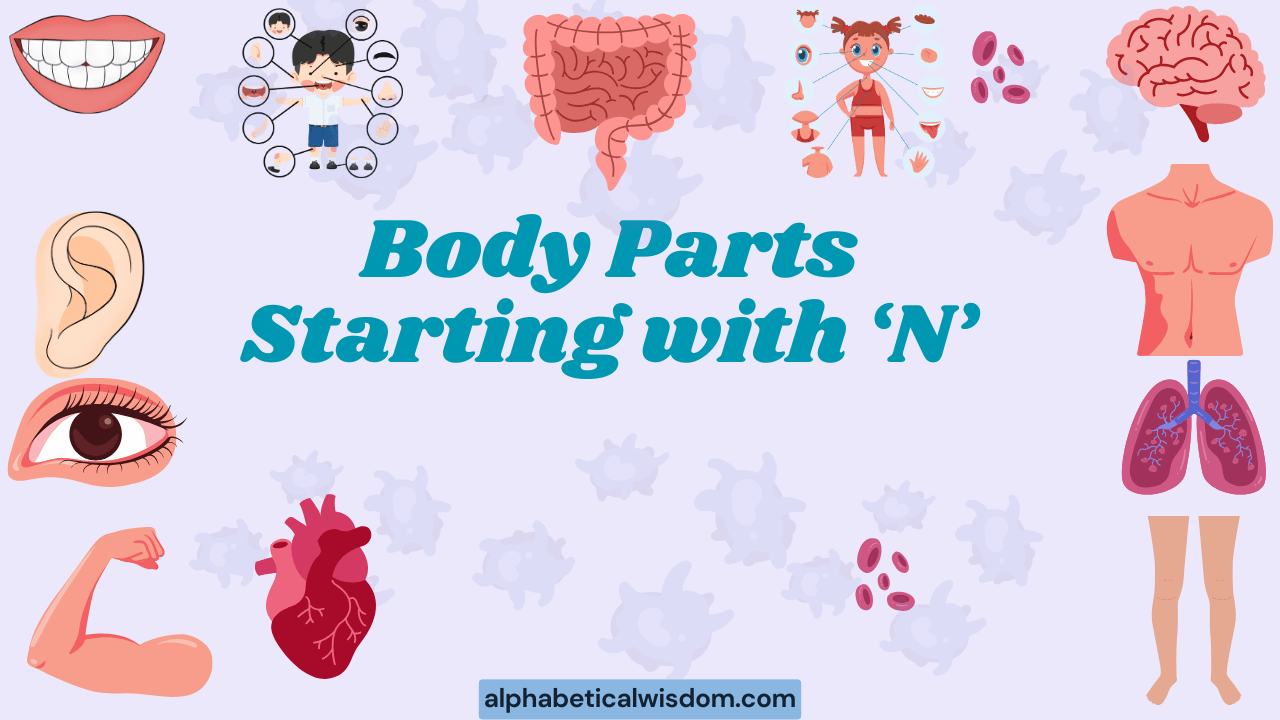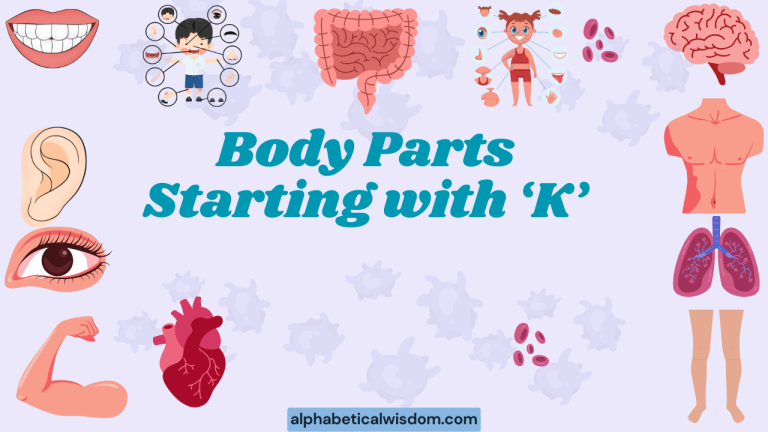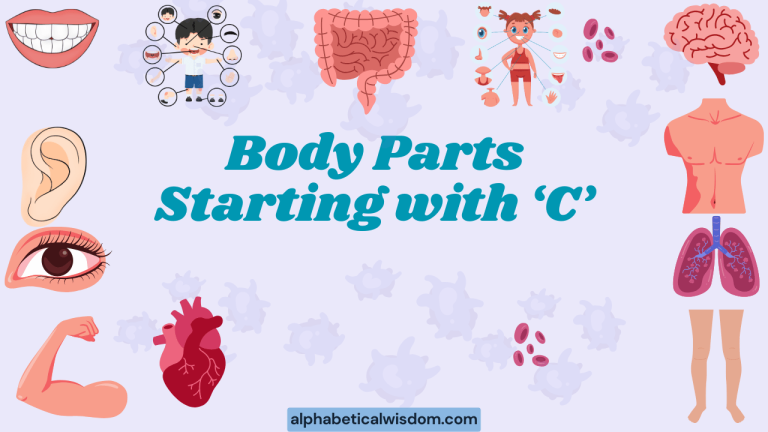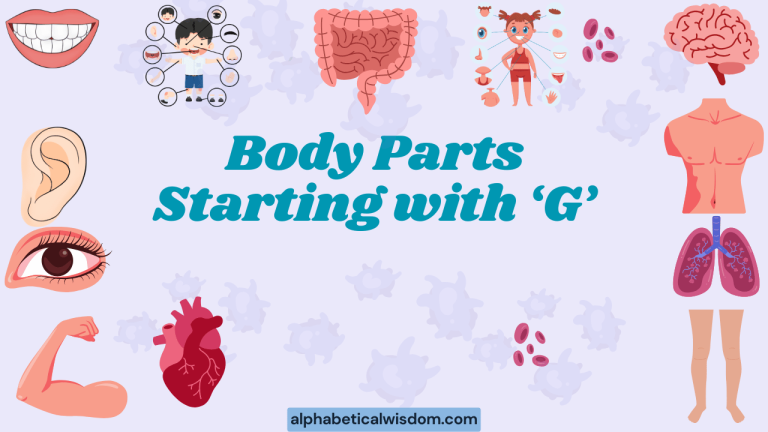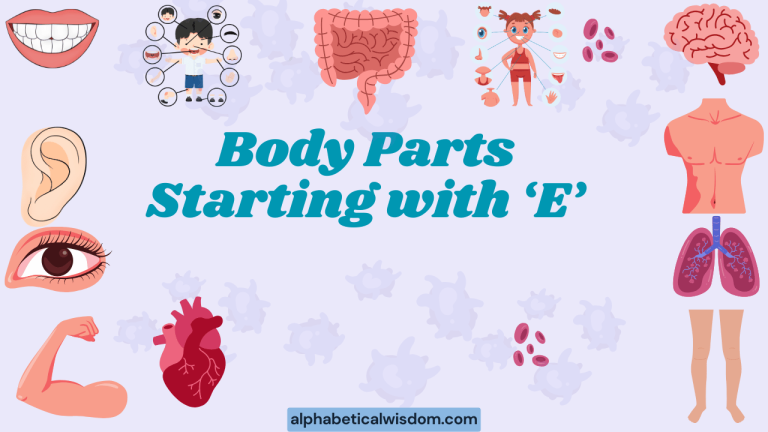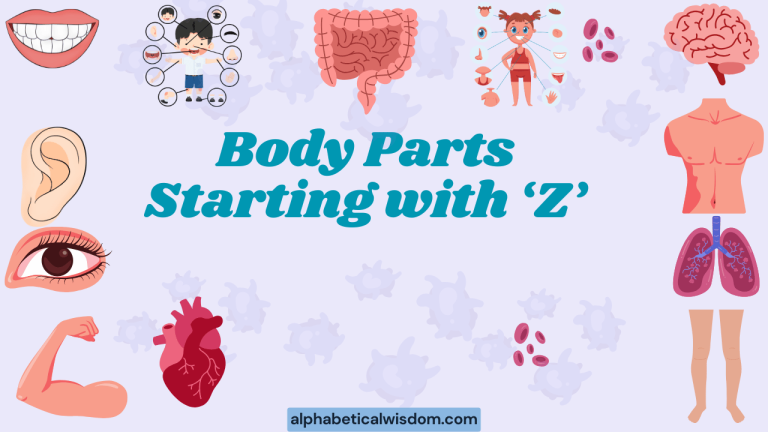Body Parts Starting with N: A Comprehensive Grammar Guide
Understanding body part vocabulary is crucial for effective communication in English. This article focuses on body parts starting with the letter ‘N,’ exploring their grammatical roles, proper usage, and common mistakes.
This guide is designed for English language learners of all levels, from beginners expanding their vocabulary to advanced speakers refining their precision. Mastering these terms enhances your ability to describe physical attributes, discuss health, and understand idiomatic expressions related to the human body.
This comprehensive overview will equip you with the knowledge and skills to confidently use these words in both spoken and written English.
Table of Contents
- Introduction
- Definition of Body Parts Starting with ‘N’
- Structural Breakdown
- Types and Categories
- Examples of Body Parts Starting with ‘N’ in Sentences
- Usage Rules
- Common Mistakes
- Practice Exercises
- Advanced Topics
- FAQ
- Conclusion
Definition of Body Parts Starting with ‘N’
This section defines and explains the primary body parts starting with the letter ‘N’ in the English language. We will discuss their classifications, functions, and the contexts in which they are typically used.
The body parts starting with ‘N’ include:
- Nose: The prominent structure protruding from the face that houses the nostrils and functions in breathing and smelling.
- Nape: The back of the neck.
- Navel: The indentation on the abdomen at the site of a former attachment of the umbilical cord; also known as the belly button.
- Nostril: One of the two external openings of the nose, used for breathing and smelling.
- Nail: A horny, protective plate on the dorsal surface of the distal phalanx of a finger or toe.
- Nerve: A whitish fiber or bundle of fibers in the body that transmits impulses of sensation to the brain or spinal cord, and impulses from these to the muscles and organs.
Structural Breakdown
The structural breakdown focuses on the grammatical roles these body parts play in sentences. They primarily function as nouns, which means they can act as subjects, objects, or complements.
Consider the following:
- Subject: The nose helps us smell.
- Object: She pierced her nose.
- Complement: That is his navel.
These nouns can also be modified by adjectives to provide more specific descriptions. For example, “a large nose,” “her slender nape,” or “a deep navel.” Understanding these structural roles is crucial for constructing grammatically correct and descriptive sentences.
Types and Categories
Body parts can be categorized in various ways depending on the context. For body parts starting with ‘N’, we can classify them based on whether they are common names or anatomical terms.
Anatomical Terms
Anatomical terms are precise and scientific, used in medical and biological contexts. These terms often have Latin or Greek origins and are used to ensure clarity and accuracy in professional settings.
Examples include:
- Nerve: Used in describing the nervous system and its functions in detail.
- Nares: A more formal term for nostrils, often used in medical contexts.
Common Names
Common names are the everyday terms used in casual conversation and general writing. They are widely understood and easily accessible to the general public.
Examples include:
- Nose: The standard term for the facial feature.
- Nape: The everyday term for the back of the neck.
- Navel: The common term for the belly button.
- Nostril: The standard term for the openings in the nose.
- Nail: The standard term for the protective plate on fingers and toes.
Examples of Body Parts Starting with ‘N’ in Sentences
This section provides extensive examples of how to use body parts starting with ‘N’ in sentences. Each subsection focuses on a specific body part, illustrating its usage in various contexts.
Nose Examples
The nose is a prominent feature, and its descriptions are common in everyday language. The following table provides multiple examples of its use in different contexts.
| Sentence | Context |
|---|---|
| She has a beautiful, upturned nose. | Describing physical appearance |
| The smell of roses filled her nose. | Describing sensory experience |
| He broke his nose during the boxing match. | Describing an injury |
| The dog nudged her hand with its wet nose. | Describing animal behavior |
| She wrinkled her nose in disgust. | Expressing emotion |
| He blew his nose loudly into a tissue. | Describing an action |
| The doctor examined her nose for signs of infection. | Medical context |
| The climber’s nose was red from the cold. | Describing physical condition |
| She applied sunscreen to her nose to prevent sunburn. | Describing a protective measure |
| He talks through his nose. | Describing speech |
| The blood was streaming from his nose. | Describing an injury |
| She pinched her nose to avoid the bad smell. | Describing sensory experience avoidance |
| He has a nose for trouble. | Idiomatic expression (sense of intuition) |
| The aroma of coffee tickled her nose. | Describing sensory experience |
| She sniffed, wiping her nose with a handkerchief. | Describing an action |
| The surgeon performed rhinoplasty to reshape her nose. | Medical context (surgical procedure) |
| His nose was running because of the cold. | Describing a symptom |
| She wore a nose ring as a fashion statement. | Describing personal style |
| The detective followed his nose to the truth. | Idiomatic expression (following a lead) |
| He has his nose in a book. | Idiomatic expression (reading intently) |
| She paid through the nose for that designer dress. | Idiomatic expression (paying a high price) |
| Don’t cut off your nose to spite your face. | Idiomatic expression (avoiding self-destructive actions) |
| Keep your nose clean. | Idiomatic expression (stay out of trouble) |
| He turned up his nose at the offer. | Idiomatic expression (rejecting something disdainfully) |
| She poked her nose into other people’s business. | Idiomatic expression (being nosy) |
| He led them by the nose. | Idiomatic expression (controlling someone completely) |
| She looks down her nose at everyone. | Idiomatic expression (acting superior) |
| He rubbed his nose thoughtfully. | Describing a gesture |
Nape Examples
The nape, or the back of the neck, is often mentioned in descriptions of posture or physical contact. Here are some examples:
| Sentence | Context |
|---|---|
| He felt a shiver run down the nape of his neck. | Describing a sensation |
| She gently massaged the nape of his neck. | Describing physical contact |
| The high collar irritated the nape of her neck. | Describing discomfort |
| He kissed the nape of her neck. | Describing affection |
| Her hair tickled the nape of her neck. | Describing a sensation |
| The sun beat down on the nape of his neck. | Describing the effect of weather |
| He felt a sudden pain in the nape of his neck. | Describing an injury |
| She wore her hair up, exposing the nape of her neck. | Describing hairstyle |
| He had a tattoo on the nape of his neck. | Describing a physical attribute |
| The cold wind whipped around the nape of her neck. | Describing the effect of weather |
| He tensed the muscles in the nape of his neck. | Describing a physical reaction |
| She felt a gentle breeze on the nape of her neck. | Describing a sensation |
| The scarf protected the nape of her neck from the cold. | Describing protection |
| He has a birthmark on the nape of his neck. | Describing a physical attribute |
| She scratched the nape of her neck nervously. | Describing a nervous habit |
| The dog licked the nape of her neck affectionately. | Describing animal behavior |
| He adjusted his collar, which was rubbing against the nape of his neck. | Describing discomfort |
| She applied sunscreen to the nape of her neck to prevent sunburn. | Describing a protective measure |
| He felt a knot of tension in the nape of his neck. | Describing physical discomfort |
| She rubbed the nape of her neck to relieve the stiffness. | Describing an action to relieve pain |
| The barber carefully shaved the hair at the nape of his neck. | Describing a grooming action |
| He felt a strange pressure at the nape of his neck. | Describing a physical sensation |
| She noticed a small mole on the nape of his neck. | Describing a physical attribute |
| The doctor examined the nape of his neck for swollen glands. | Medical context |
| He felt someone breathing down the nape of his neck. | Describing a sensation of being watched |
| She often wore necklaces that draped down the nape of her neck. | Describing personal style |
| He winced as the cold metal touched the nape of his neck. | Describing a physical reaction |
Navel Examples
The navel, or belly button, is a specific anatomical feature. Here are some examples of its use in sentences:
| Sentence | Context |
|---|---|
| She has an outie navel. | Describing physical appearance |
| He cleaned his navel with a cotton swab. | Describing hygiene |
| Her dress revealed her navel. | Describing clothing style |
| The baby’s umbilical cord was cut close to the navel. | Describing infancy |
| She had a piercing in her navel. | Describing personal style |
| He applied lotion around his navel. | Describing skincare |
| The doctor examined the area around her navel. | Medical context |
| She felt a tickle around her navel. | Describing a sensation |
| He has an innie navel. | Describing physical appearance |
| She decorated her navel with a temporary tattoo. | Describing personal style |
| The toddler poked his finger into his navel. | Describing a child’s action |
| She felt a strange sensation around her navel during pregnancy. | Describing a physical sensation during pregnancy |
| He noticed a slight redness around his navel. | Describing a physical symptom |
| She applied a bandage to her navel after the piercing. | Describing aftercare |
| He cleaned the area around his navel to prevent infection. | Describing hygiene |
| She felt a fluttery feeling around her navel. | Describing a physical sensation |
| He has a small scar near his navel from a previous surgery. | Describing a physical attribute |
| She wore a crop top that showed off her navel. | Describing clothing style |
| He felt a sharp pain near his navel. | Describing a physical symptom |
| She covered her navel with sunscreen. | Describing a protective measure |
| The baby’s navel was cleaned with alcohol until it healed. | Describing infant care |
| He felt a tightening sensation around his navel. | Describing a physical sensation |
| She decorated her navel with a small jewel. | Describing personal style |
| He had a navel piercing removed due to infection. | Describing a health issue |
| She felt a pulling sensation near her navel during exercise. | Describing a physical sensation during exercise |
Nail Examples
Nails are common body parts that are often discussed in the context of grooming and health. The following are examples of how to use “nails” in sentences:
| Sentence | Context |
|---|---|
| She painted her nails red. | Describing grooming |
| He bit his nails when he was nervous. | Describing a habit |
| Her nails were long and manicured. | Describing physical appearance |
| He trimmed his nails with clippers. | Describing grooming |
| She broke a nail while gardening. | Describing an accident |
| She filed her nails into a perfect oval shape. | Describing grooming |
| He has dirt under his nails from working in the garden. | Describing physical condition |
| She got acrylic nails for a special occasion. | Describing grooming |
| He noticed a discoloration on his nails. | Describing a health issue |
| She strengthened her nails with a special polish. | Describing grooming |
| He stubbed his toe and damaged his nail. | Describing an injury |
| She pushed back her cuticles to make her nails look longer. | Describing grooming |
| He keeps his nails short and clean. | Describing grooming habits |
| She applied a base coat to protect her nails. | Describing grooming |
| He has a fungal infection in his toenails. | Describing a health issue |
| She soaked her nails in warm water before a manicure. | Describing grooming preparation |
| He used a nail brush to clean under his nails. | Describing grooming |
| She polished her nails with a glittery topcoat. | Describing grooming |
| He uses a nail file to smooth the edges of his nails. | Describing grooming |
| She decorated her nails with intricate designs. | Describing grooming |
| He accidentally slammed his finger in the door and bruised his nail. | Describing an injury |
| She uses a nail strengthener to prevent breakage. | Describing grooming |
| He has ridges on his nails. | Describing a physical attribute |
| She uses a cuticle oil to keep her nails moisturized. | Describing grooming |
Nerve Examples
The term “nerve” is commonly used in both medical and figurative contexts. Here are some examples:
| Sentence | Context |
|---|---|
| The doctor examined the nerve damage in his leg. | Medical context |
| She had a pinched nerve in her back. | Describing a health issue |
| He lost his nerve at the last minute. | Idiomatic expression (losing courage) |
| The pain shot through his nerve endings. | Describing a sensation |
| She has nerves of steel. | Idiomatic expression (being very brave) |
| The surgeon carefully avoided damaging any nerves. | Medical context |
| He got on her nerves. | Idiomatic expression (irritating someone) |
| The nerve impulses traveled quickly to the brain. | Scientific context |
| She calmed her nerves before the presentation. | Describing emotional state |
| He felt a tingling sensation in his nerve endings. | Describing a sensation |
| The carpal tunnel syndrome affected the nerve in her wrist. | Medical context |
| She tried not to let her nerves show. | Describing emotional state |
| He had the nerve to ask for a raise. | Idiomatic expression (audacity) |
| The nerve block relieved the pain. | Medical context |
| She was a bundle of nerves before the exam. | Describing emotional state |
| He felt a sharp pain along the course of the nerve. | Describing a sensation |
| The doctor tested the reflexes of his nerves. | Medical context |
| She was on edge, her nerves frayed. | Describing emotional state |
| He needed to develop more nerve to succeed in business. | Idiomatic expression (courage) |
| The medication helped to calm her nerves. | Describing medical treatment |
Usage Rules
Understanding the grammatical rules governing the use of these body parts is essential for accurate and effective communication.
Singular vs. Plural
Most body parts can be either singular or plural depending on the context. For example:
- Singular: “He has a nose.”
- Plural: “She has two nostrils.”
The plural form is usually created by adding ‘-s’ to the end of the word.
Using Articles (a, an, the)
The choice of article depends on whether the body part is being referred to in a general or specific sense.
- A/An: Used when referring to a body part in a general sense. “He has a nose.”
- The: Used when referring to a specific body part, often in relation to someone. “She broke the nose.”
Possessive Adjectives
Possessive adjectives (my, your, his, her, its, our, their) are used to indicate ownership or association.
- “She touched her nose.”
- “He scratched his nape.”
Using Prepositions
Prepositions are used to show the relationship between the body part and other elements in the sentence.
- “The glasses are on his nose.”
- “She felt a pain in the nape of her neck.”
Common Mistakes
Learners often make mistakes with articles and singular/plural forms. Here are some common errors and their corrections:
| Incorrect | Correct | Explanation |
|---|---|---|
| I have a noses. | I have a nose. | Incorrect plural form after the article ‘a’. |
| She touched the nose. | She touched her nose. | Missing possessive adjective. |
| He felt pain in nape. | He felt pain in the nape. | Missing article ‘the’ to specify the area. |
| They have two nose. | They have two noses. | Incorrect singular form when referring to two. |
| She cleaned a navel. | She cleaned her navel. | Missing possessive adjective. |
Practice Exercises
These exercises will help you reinforce your understanding of body parts starting with ‘N’.
Exercise 1: Fill in the Blanks
Fill in the blanks with the correct body part starting with ‘N’.
| Question | Answer |
|---|---|
| He broke his ______ in the fight. | nose |
| She felt a shiver down the ______ of her neck. | nape |
| The baby’s ______ was still healing. | navel |
| The cold air stung his ______. | nostrils |
| She painted her ______. | nails |
| The doctor checked the ______ function. | nerve |
| She has a piercing in her ______. | nostril |
| The cat licked the ______ of her neck. | nape |
| He cleaned his ______ with a cotton swab. | navel |
| She had a damaged ______ in her arm. | nerve |
Exercise 2: Correct the Sentences
Correct the following sentences that contain errors in the use of body parts starting with ‘N’.
| Incorrect Sentence | Correct Sentence |
|---|---|
| I have a noses. | I have a nose. |
| She touched the nose. | She touched her nose. |
| He felt pain in nape. | He felt pain in the nape. |
| They have two nose. | They have two noses. |
| She cleaned a navel. | She cleaned her navel. |
| He hurt the nerve. | He hurt his nerve. |
| The ring is in the nostril. | The ring is in her nostril. |
| She massaged nape. | She massaged the nape. |
| He has dirt under nail. | He has dirt under his nails. |
| I have a damage nerve in the back. | I have a damaged nerve in my back. |
Exercise 3: Sentence Building
Create sentences using the following words:
| Word | Example Sentence |
|---|---|
| Nose | The dog sniffed the flower with its nose. |
| Nape | He felt a gentle touch on the nape of his neck. |
| Navel | She has a small, neat navel. |
| Nostrils | The cold air made her nostrils sting. |
| Nails | She painted her nails a vibrant blue. |
| Nerve | The dentist numbed the nerve before the procedure. |
| Navels | The dancers showed off their navels. |
| Nerves | He had pre-show jitters and had to calm his nerves. |
| Nostril | A piercing adorned her right nostril. |
Advanced Topics
For advanced learners, understanding idiomatic expressions and medical terminology related to these body parts can further enhance their language proficiency.
Idiomatic Expressions
Idiomatic expressions add color and depth to the language. Here are some idioms using body parts starting with ‘N’:
- By the skin of one’s teeth: Barely escaping a dangerous situation.
- Get something off one’s chest: To confess something that has been bothering you.
- Keep your chin up: Stay positive.
Medical Terminology
In medical contexts, specific terms are used to describe conditions and procedures related to these body parts. For example:
- Rhinoplasty: Surgical repair or reconstruction of the nose.
- Neuralgia: Intense, typically intermittent pain along the course of a nerve.
FAQ
Here are some frequently asked questions about using body parts starting with ‘N’.
- What is the difference between ‘nape’ and ‘neck’?
The ‘nape’ specifically refers to the back of the neck, while ‘neck’ is a more general term encompassing the entire area between the head and shoulders.
- When should I use ‘nares’ instead of ‘nostrils’?
‘Nares’ is a more formal, anatomical term often used in medical or scientific contexts, while ‘nostrils’ is the common, everyday term.
- Is it correct to say “He has a nice nose” or “He has a nice the nose”?
The correct sentence is “He has a nice nose.” The article ‘a’ is used because you are referring to a nose in a general, non-specific way. Using ‘the’ would imply you are referring to a specific nose already known to the listener.
- What are some common health problems associated with the nose?
Common health problems include nasal congestion, sinusitis, nosebleeds, and deviated septum.
- How can I improve my vocabulary related to body parts?
Read medical articles, and anatomy books, use flashcards, and practice using the words in sentences. Pay attention to how native speakers use these terms in conversation and writing.
- What is the difference between a ‘nerve’ and a ‘neuron’?
A neuron is a single nerve cell, while a nerve is a bundle of neurons. Think of a nerve as a cable made up of many individual wires (neurons).
- How do I know when to use a possessive adjective with a body part?
Use a possessive adjective (my, your, his, her, its, our, their) when the body part belongs to or is associated with a specific person or thing. For example, “She washed her face” (the face belongs to her).
- Why is it important to use correct grammar when talking about body parts?
Using correct grammar ensures clear and accurate communication, especially in medical or health-related contexts. Misunderstandings can lead to confusion or even misdiagnosis.
- What are some common idioms using the word “nerve”?
Some common idioms include “get on someone’s nerves” (to irritate someone), “have a nerve” (to be audacious), and “nerves of steel” (to be very brave).
- Can you say “the navel of the earth”? What does it mean?
Yes, you can say “the navel of the earth.” It is a metaphorical expression that refers to a central or most important place. It often has spiritual or mythical connotations, suggesting a place of origin or connection to the divine.
Conclusion
Mastering the use of body parts starting with the letter ‘N’ enhances your English vocabulary and improves your ability to communicate effectively about health, physical descriptions, and various sensations. By understanding the grammatical rules, common mistakes, and idiomatic expressions associated with these words, you can significantly improve your language skills.
Remember to practice regularly and pay attention to how these terms are used in real-world contexts. Continuous learning and consistent practice are key to achieving fluency and confidence in English.
